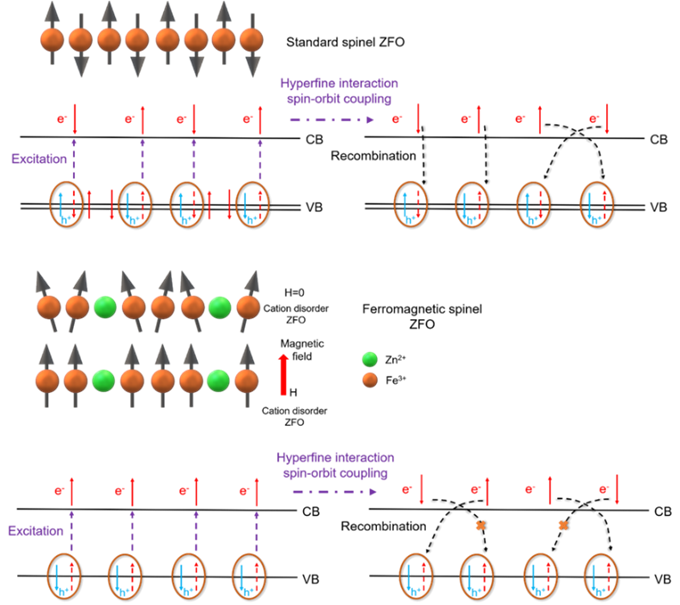Recently, Prof. Liu Hong’s group from the State Key Laboratory of Crystal Materials of Shandong University proposed a strategy to enhance the photoinduced charge separation in ferromagnetic photocatalysts by electron spin polarization. The related work was published as a research paper entitled “Electron Spin Polarization-Enhanced Photoinduced Charge Separation in Ferromagnetic ZnFe2O4” in ACS Energy Letters (IF=19). Prof. Sang Yuanhua, Prof. Liu Hong and Prof. Ma Yandong are the corresponding authors. PhD candidate Gao Wenqiang is the first author. The State Key Laboratory of Crystal Materials of Shandong University is the first corresponding author institute.
In this work, ZnFe2O4(ZFO) materials with an enhanced ferromagnetic property were realized by introducing cation disorder and oxygen vacancies. The photoelectrochemical (PEC) catalytic performance was significantly improved in a magnetic field, and the ferromagnetic ZFO sample achieved an obvious photocurrent increased simply by placing a permanent magnet that provides a magnetic field perpendicular to the photoelectrode. The improvement in PEC performance is due to magnetic field-derived ferromagnetic ZFO electron spin polarization, which suppresses the recombination of photoinduced carriers based on the Pauli exclusion principle and provides a better charge transfer channel based on the magnetoresistance (MR) effect. This strategy further broadens the idea of utilizing material structure design to achieve magnetic field-promoted electron spin polarization for high-efficiency PEC systems.

In recent studies, Liu Hong’s group focused on the external field modified photoinduced charge separation of powder photocatalysts. Based on the magnetic Lorentz force, the photoinduced carrier recombination was directly suppressed (Advanced Science, 2019, 6, 1901224). Based on the in situ micro-potential of nanomaterials, the conversion of mechanical energy to electric potential energy by applying piezoelectric materials (Nano Lett.2015, 15, 2372-2379), and the conversion of kinetic energy to electric potential energy via electromagnetic induction were proposed and applied in the enhancement of charge separation (Nano Energy, 2020, 69, 104448,Nano Energy, 2021, 80, 105543 andChem. Eng. J., 2021, 404, 126972).
This work was supported by the State Key Laboratory of Crystal Materials, and the funding from National Key Research and Development Program of China, National Natural Science Foundation of China, Science Fund for Distinguished Young Scholars of Shandong Province, as well as the Construction Engineering Special Fund of “Taishan Scholars” of Shandong Province.
